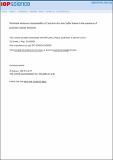Files in this item
Nonlinear emission characteristics of quantum dot-micropillar lasers in the presence of polarized optical feedback
Item metadata
| dc.contributor.author | Hopfmann, C. | |
| dc.contributor.author | Albert, F. | |
| dc.contributor.author | Schneider, C. | |
| dc.contributor.author | Höfling, Sven | |
| dc.contributor.author | Kamp, M. | |
| dc.contributor.author | Forchel, A. | |
| dc.contributor.author | Kanter, I. | |
| dc.contributor.author | Reitzenstein, S. | |
| dc.date.accessioned | 2014-01-17T15:31:05Z | |
| dc.date.available | 2014-01-17T15:31:05Z | |
| dc.date.issued | 2013-02-22 | |
| dc.identifier | 73421418 | |
| dc.identifier | d4ca7aec-82f0-4cda-98a9-ffa415afce0e | |
| dc.identifier | 000315525000002 | |
| dc.identifier | 84874514101 | |
| dc.identifier.citation | Hopfmann , C , Albert , F , Schneider , C , Höfling , S , Kamp , M , Forchel , A , Kanter , I & Reitzenstein , S 2013 , ' Nonlinear emission characteristics of quantum dot-micropillar lasers in the presence of polarized optical feedback ' , New Journal of Physics , vol. 15 , 025030 . https://doi.org/10.1088/1367-2630/15/2/025030 | en |
| dc.identifier.issn | 1367-2630 | |
| dc.identifier.uri | https://hdl.handle.net/10023/4388 | |
| dc.description.abstract | We report on electrically pumped quantum dot-microlasers in the presence of polarized self-feedback. The high-beta microlasers show two orthogonal, linearly polarized emission modes which are coupled via the common gain medium. This coupling is explained in terms of gain competition between the two lasing modes and leads to distinct differences in their input-output characteristics. By applying polarized self-feedback via an external mirror, we are able to control the laser characteristics of the emission modes in terms of the output power, the coherence time and the photon statistics. We find that linearly polarized self-feedback stabilizes the lasing of a given mode, while cross-polarized feedback between the two modes reduces strongly the intensity of the other emission mode showing particular high-intensity fluctuations and even super-thermal values of the photon autocorrelation function g((2)) (tau) at zero delay. Measurements of g((2)) (tau) under external feedback also allow us to detect revival peaks associated with the round trip time of the external cavity. Analyzing the damping and shape of the g((2)) (tau) revival peaks by a phenomenological model provides us insight into the underlying physics such as the effective exciton lifetime and gain characteristics of the quantum dots in the active region of these microlasers. | |
| dc.format.extent | 17 | |
| dc.format.extent | 1389405 | |
| dc.language.iso | eng | |
| dc.relation.ispartof | New Journal of Physics | en |
| dc.subject | Semiconductor-lasers | en |
| dc.subject | Coherence | en |
| dc.subject | Polarized self-feedback | en |
| dc.title | Nonlinear emission characteristics of quantum dot-micropillar lasers in the presence of polarized optical feedback | en |
| dc.type | Journal article | en |
| dc.contributor.institution | University of St Andrews. School of Physics and Astronomy | en |
| dc.contributor.institution | University of St Andrews. Condensed Matter Physics | en |
| dc.identifier.doi | 10.1088/1367-2630/15/2/025030 | |
| dc.description.status | Peer reviewed | en |
This item appears in the following Collection(s)
Items in the St Andrews Research Repository are protected by copyright, with all rights reserved, unless otherwise indicated.

